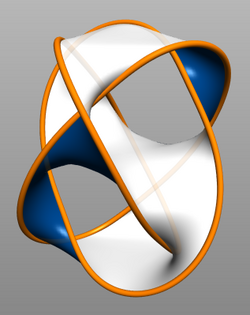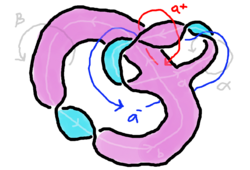Seifert surface

In mathematics, a Seifert surface (named after Germany mathematician Herbert Seifert[1][2]) is an orientable surface whose boundary is a given knot or link.
Such surfaces can be used to study the properties of the associated knot or link. For example, many knot invariants are most easily calculated using a Seifert surface. Seifert surfaces are also interesting in their own right, and the subject of considerable research.
Specifically, let L be a tame oriented knot or link in Euclidean 3-space (or in the 3-sphere). A Seifert surface is a compact, connected, oriented surface S embedded in 3-space whose boundary is L such that the orientation on L is just the induced orientation from S.
Note that any compact, connected, oriented surface with nonempty boundary in Euclidean 3-space is the Seifert surface associated to its boundary link. A single knot or link can have many different inequivalent Seifert surfaces. A Seifert surface must be oriented. It is possible to associate surfaces to knots which are not oriented nor orientable, as well.
Examples
The standard Möbius strip has the unknot for a boundary but is not a Seifert surface for the unknot because it is not orientable.
The "checkerboard" coloring of the usual minimal crossing projection of the trefoil knot gives a Mobius strip with three half twists. As with the previous example, this is not a Seifert surface as it is not orientable. Applying Seifert's algorithm to this diagram, as expected, does produce a Seifert surface; in this case, it is a punctured torus of genus g = 1, and the Seifert matrix is
- [math]\displaystyle{ V = \begin{pmatrix}1 & -1 \\ 0 & 1\end{pmatrix}. }[/math]
Existence and Seifert matrix
It is a theorem that any link always has an associated Seifert surface. This theorem was first published by Frankl and Pontryagin in 1930.[3] A different proof was published in 1934 by Herbert Seifert and relies on what is now called the Seifert algorithm. The algorithm produces a Seifert surface [math]\displaystyle{ S }[/math], given a projection of the knot or link in question.
Suppose that link has m components (m = 1 for a knot), the diagram has d crossing points, and resolving the crossings (preserving the orientation of the knot) yields f circles. Then the surface [math]\displaystyle{ S }[/math] is constructed from f disjoint disks by attaching d bands. The homology group [math]\displaystyle{ H_1(S) }[/math] is free abelian on 2g generators, where
- [math]\displaystyle{ g = \frac{1}{2}(2 + d - f - m) }[/math]
is the genus of [math]\displaystyle{ S }[/math]. The intersection form Q on [math]\displaystyle{ H_1(S) }[/math] is skew-symmetric, and there is a basis of 2g cycles [math]\displaystyle{ a_1, a_2, \ldots, a_{2g} }[/math] with [math]\displaystyle{ Q = (Q(a_i, a_j)) }[/math] equal to a direct sum of the g copies of the matrix
- [math]\displaystyle{ \begin{pmatrix} 0 & -1 \\ 1 & 0 \end{pmatrix} }[/math]
The 2g × 2g integer Seifert matrix
- [math]\displaystyle{ V = (v(i, j)) }[/math]
has [math]\displaystyle{ v(i, j) }[/math] the linking number in Euclidean 3-space (or in the 3-sphere) of ai and the "pushoff" of aj in the positive direction of [math]\displaystyle{ S }[/math]. More precisely, recalling that Seifert surfaces are bicollared, meaning that we can extend the embedding of [math]\displaystyle{ S }[/math] to an embedding of [math]\displaystyle{ S \times [-1, 1] }[/math], given some representative loop [math]\displaystyle{ x }[/math] which is homology generator in the interior of [math]\displaystyle{ S }[/math], the positive pushout is [math]\displaystyle{ x \times \{1\} }[/math] and the negative pushout is [math]\displaystyle{ x \times \{-1\} }[/math].[4]
With this, we have
- [math]\displaystyle{ V - V^* = Q, }[/math]
where V∗ = (v(j, i)) the transpose matrix. Every integer 2g × 2g matrix [math]\displaystyle{ V }[/math] with [math]\displaystyle{ V - V^* = Q }[/math] arises as the Seifert matrix of a knot with genus g Seifert surface.
The Alexander polynomial is computed from the Seifert matrix by [math]\displaystyle{ A(t) = \det\left(V - tV^*\right), }[/math] which is a polynomial of degree at most 2g in the indeterminate [math]\displaystyle{ t. }[/math] The Alexander polynomial is independent of the choice of Seifert surface [math]\displaystyle{ S, }[/math] and is an invariant of the knot or link.
The signature of a knot is the signature of the symmetric Seifert matrix [math]\displaystyle{ V + V^\mathrm{T}. }[/math] It is again an invariant of the knot or link.
Genus of a knot
Seifert surfaces are not at all unique: a Seifert surface S of genus g and Seifert matrix V can be modified by a topological surgery, resulting in a Seifert surface S′ of genus g + 1 and Seifert matrix
- [math]\displaystyle{ V' = V \oplus \begin{pmatrix} 0 & 1 \\ 1 & 0 \end{pmatrix}. }[/math]
The genus of a knot K is the knot invariant defined by the minimal genus g of a Seifert surface for K.
For instance:
- An unknot—which is, by definition, the boundary of a disc—has genus zero. Moreover, the unknot is the only knot with genus zero.
- The trefoil knot has genus 1, as does the figure-eight knot.
- The genus of a (p, q)-torus knot is (p − 1)(q − 1)/2
- The degree of a knot's Alexander polynomial is a lower bound on twice its genus.
A fundamental property of the genus is that it is additive with respect to the knot sum:
- [math]\displaystyle{ g(K_1 \mathbin{\#} K_2) = g(K_1) + g(K_2) }[/math]
In general, the genus of a knot is difficult to compute, and the Seifert algorithm usually does not produce a Seifert surface of least genus. For this reason other related invariants are sometimes useful. The canonical genus [math]\displaystyle{ g_c }[/math] of a knot is the least genus of all Seifert surfaces that can be constructed by the Seifert algorithm, and the free genus [math]\displaystyle{ g_f }[/math] is the least genus of all Seifert surfaces whose complement in [math]\displaystyle{ S^3 }[/math] is a handlebody. (The complement of a Seifert surface generated by the Seifert algorithm is always a handlebody.) For any knot the inequality [math]\displaystyle{ g \leq g_f \leq g_c }[/math] obviously holds, so in particular these invariants place upper bounds on the genus.[5]
The knot genus is NP-complete by work of Ian Agol, Joel Hass and William Thurston.[6]
It has been shown that there are Seifert surfaces of the same genus that do not become isotopic either topologically or smoothly in the 4-ball.[7][8]
See also
References
- ↑ Seifert, H. (1934). "Über das Geschlecht von Knoten" (in de). Math. Annalen 110 (1): 571–592. doi:10.1007/BF01448044.
- ↑ van Wijk, Jarke J.; Cohen, Arjeh M. (2006). "Visualization of Seifert Surfaces". IEEE Transactions on Visualization and Computer Graphics 12 (4): 485–496. doi:10.1109/TVCG.2006.83. PMID 16805258.
- ↑ Frankl, F.; Pontrjagin, L. (1930). "Ein Knotensatz mit Anwendung auf die Dimensionstheorie" (in de). Math. Annalen 102 (1): 785–789. doi:10.1007/BF01782377.
- ↑ Dale Rolfsen. Knots and Links. (1976), 146-147.
- ↑ Brittenham, Mark (24 September 1998). "Bounding canonical genus bounds volume". arXiv:math/9809142.
- ↑ Agol, Ian; Hass, Joel; Thurston, William (2002-05-19). "3-manifold knot genus is NP-complete". Proceedings of the thiry-fourth annual ACM symposium on Theory of computing. STOC '02. New York, NY, USA: Association for Computing Machinery. pp. 761–766. doi:10.1145/509907.510016. ISBN 978-1-58113-495-7. https://doi.org/10.1145/509907.510016.
- ↑ Hayden, Kyle; Kim, Seungwon; Miller, Maggie; Park, JungHwan; Sundberg, Isaac (2022-05-30). "Seifert surfaces in the 4-ball". arXiv:2205.15283 [math.GT].
- ↑ "Special Surfaces Remain Distinct in Four Dimensions" (in en). 2022-06-16. https://www.quantamagazine.org/special-surfaces-remain-distinct-in-four-dimensions-20220616/.
External links
- The SeifertView programme of Jack van Wijk visualizes the Seifert surfaces of knots constructed using Seifert's algorithm.
 |



